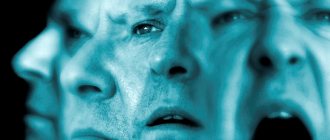Alcoholic hallucinosis is a neuropsychiatric disorder that occurs as a result of chronic consumption of ethanol-containing drinks and is manifested by the development of auditory and/or visual hallucinations in the patient.
Alcoholic hallucinosis (hereinafter referred to as hypertension) affects people in stages II and III of alcoholism, and according to statistics, women suffer from this disorder much more often. Hypertension can be both short-term and chronic, but in general it is not prone to recurrence.
A noteworthy feature: hypertension is almost never combined with alcoholic dementia - in most cases, the consciousness and self-awareness of hallucinating patients do not undergo any disturbances.
Content:
- Total information
- Causes of mental disorder
- Features of varieties of hallucinatory psycho
- Symptoms and clinical picture
- Treatment
Among the metal-alcohol psychoses characteristic of advanced stages of alcoholism, delirium (delirium tremens) comes first. Alcoholic hallucinosis ranks second in frequency of occurrence. Its main manifestations include auditory (verbal) hallucinations, delusions, and anxiety-affective disorders. Moreover, in contrast to delirious psychotic disorders, spatial-personal orientation and consciousness are fully or partially preserved. Patients of this type pose a social danger and require treatment in specialized hospitals.
General symptoms of hallucinosis
A common feature for all hallucinosis is the person’s retention of consciousness. The patient understands who he is, what time it is, and where he is. Otherwise, the clinical picture of the problem depends on the type of disease. Charles Bonnet syndrome causes:
- cartoon visions;
- people with distorted facial features;
- hallucinations appear and disappear suddenly;
- The pictures are saved in full.
Often this phenomenon is combined with atherosclerosis, and sometimes accompanies senile dementia, in which case hallucinosis is eliminated and Alzheimer's is treated.
In Lhermitte's disease, hallucinosis manifests itself somewhat differently:
- observed in the dark;
- They look like vague images of animals or people.
In the verbal form of the disease the following are noted:
- voices (one or several);
- they discuss him and his surroundings;
- ordered to perform certain actions.
Treatment of hallucinosis of alcohol origin is carried out after consultation with a narcologist; this type of mental disorder is characterized by the following symptoms:
- high anxiety;
- fear without reason;
- vivid and believable visual images;
- voices coming from objects;
- obsessive thoughts about death or the death of relatives;
- sleep disturbance;
- suicide attempts.
Total information
For every 5 cases of delirium tremens, there is 1 hallucinatory delusion. It develops mainly in the 10-11th year of alcoholism, but not earlier than 7-8 years after the development of stage I. The age range of those in need of help is 30-50 years. Most patients are aged 40 years. Women get sick more often than men in a ratio of 2:1. Dominant symptom: auditory hallucinations. Voices are of the most diverse nature and can be both single and multiple. The fear that accompanies them leads the patient to delusions of persecution and attempts to “protect” himself from them. In this state, the patient can cause injuries and mutilation to himself and others. Suicide attempts are common. With this painful status, mandatory inpatient care is required.
Features of organic hallucinosis
When a deviation occurs, the person is fully conscious and can think critically about the problem. Treatment of hallucinosis in Moscow is carried out mainly in people from 45 to 65 years old, most often women become patients.
Numerous experimental works by scientists indicate that hallucinations arise as a result of irritation of certain parts of the brain. Most often, the organic form of hallucinosis occurs due to the presence of intoxication due to an infectious disease, neurological or vascular disease, or disruption of the functioning of the sensory organs. The following factors can provoke the appearance of this deviation:
- taking psychostimulants (alcoholism and drug addiction);
- drug poisoning;
- damage to brain tissue by tumor, injury;
- epilepsy;
- migraine with pre-existing aura;
- oxygen starvation of brain structures due to vascular disorders;
- deafness and blindness.
With this form of disorder, the patient’s comprehension of what is happening is slower than that of a healthy person. This phenomenon is often used in the diagnosis of deviation. Treatment of hallucinosis in this case is necessary, since the disease can progress rapidly and lead to severe apathy and memory impairment. The patient also exhibits the following symptoms:
- poverty of associations;
- reluctance to engage in conversations;
- emotional stinginess;
- lethargy and dysphoria;
- causeless aggression (sometimes);
- impulsiveness;
- difficulty controlling emotions;
- stereotypical speech and thinking.
Causes of mental disorder
Any alcoholic hallucinosis is a consequence of abuse of alcohol-containing drinks at the level of chronic alcoholism. Approximately half of those who exhibit symptoms of this disorder suffer from stage II of the disease. In the other part, phase III is detected.
The development of psychotic disturbances is facilitated by:
- Malignant course of alcohol addiction.
- Concomitant neurological pathology.
- Traumatic injuries, inflammatory and degenerative diseases of the brain, alcoholic encephalopathy.
- Co-occurring abuse of other psychoactive substances.
- Large doses of alcohol taken.
Treatment of acute psychosis after binge drinking
All victims with suspected alcohol use disorders are subject to mandatory hospitalization in a hospital. Strict measures are due to the risk of harm to oneself (suicide) or others. The danger is eliminated only after timely relief of all symptoms.
Medication
Patients must be under 24-hour staff supervision. Therapeutic assistance consists of the following activities:
- Emergency detoxification is the rapid removal of ethanol and its metabolites from tissues. Methods of forced diuresis and extracorporeal blood purification (hardware hemodialysis, plasmapheresis) are used.
- Rehydration – combating dehydration with the help of detoxifying liquids.
- Infusion therapy - droppers containing solutions to eliminate electrolyte imbalance, hypovitaminosis, and metabolic changes.
- Normalization of respiratory and circulatory functions.
- Prevention or emergency relief of acute kidney/liver damage.
- Treatment of concomitant pathology.
- Fighting pulmonary and cerebral edema.
- Motor agitation is treated with benzodiazepine tranquilizers.
- Psychotropic drugs – neuroleptics, antidepressants.
- Repeated courses of multicomponent vitamin therapy.
Treatment is supplemented with nootropic drugs, for example, piracetam. However, they show minimal effectiveness as part of complex therapy. The length of hospital stay depends on the severity of the general condition.
Psychotherapy
In case of chronic complications, patients are selected an individual program of psychotherapeutic assistance. Personal and group, family consultations help maintain a stable condition. The measures taken increase the effectiveness of pharmaceutical treatment and slow down the progression of the general disease.
Features of types of hallucinatory psychosis
There are three types of process depending on the duration and intensity of manifestations.
In narcology, the following classification by flow is used:
- Spicy option. Lasts from several hours to 1 month.
- Subacute. The duration of this type is from 1 to 6 months.
- Chronic. The clinical picture appears for more than six months.
Acute hallucinatory psychoses have the following varieties:
- Classical.
- Reduced.
- Atypical.
- Mixed.
Each variety includes its own flow characteristics, which will be described below. The first attack of alcoholic hallucinosis can develop after a single intake of a massive dose of strong alcohol (more than 1 liter), or during a binge. But in most cases, this mental disorder manifests itself during the period of withdrawal syndrome.
Consequences
Possible consequences of psychotic complications:
- more severe, rapidly progressing dependence syndrome;
- periods of remission become shorter;
- increased organic damage to the brain, which is manifested by chronic encephalopathy;
- reduction of professional and labor qualifications;
- committing antisocial acts;
- aggression and violent actions towards loved ones and others;
- persistent memory impairment;
- the patient receives injuries, often incompatible with life;
- loss of family;
- personality degradation with a decrease in cognitive and thinking abilities;
- isolation from society;
- inability to self-service;
- causing road traffic accidents and industrial emergencies;
- exacerbation of other chronic diseases;
- death.
Metal-alcohol psychoses can be isolated, repeated, or not occur at all, even with continued abuse. The course of each clinical case is individual, so the prognosis depends on the individual patient.
Symptoms and clinical picture
The onset of psychosis is sudden.
When monitoring the patient over the previous day, the following are revealed:
- Anxiety.
- Suspicion and mistrust.
- Internal tension and poor sleep.
The course of the classic form of alcoholic hallucinosis:
- The appearance of multiple auditory hallucinations. Voices are heard from both people and objects. They threaten the patient, laugh at him, scold him, mock him and ridicule him.
- Formation of interpretive delusions. It most often takes the form of persecution. The patient is sure that they want to kill him or his loved ones, subject him to torture, bullying, and humiliation.
- Expressed fear. Phobias have a strong accent, forcing the sufferer to run away, hide, and actively defend themselves. In this status, a person is socially dangerous.
Reduced alcoholic hallucinosis manifests itself:
- In the evening, when falling asleep, in a semi-drowsy state, the patient experiences acoasms and phonemes - elementary verbal hallucinations. With these disorders, individual sounds are heard in the form of unclear noise, ringing, gunshots, excerpts of music, tapping, individual syllables, words and phrases of different content.
- Active participation of the alcoholic in verbal hallucinatory experiences. He talks, explains, makes excuses and proves something.
- Waking up with an anxious and low mood. Gradually, when talking with him, a critical attitude towards the experience appears.
The atypical form is characterized not only by hallucinatory symptoms, but also by the occurrence of disturbances of consciousness: stupor, affective disorders.
Mixed formats of hallucinosis are combined with symptoms:
- Delirium.
- Severe paranoid delusions of persecution or physical destruction.
- Hallucinations of a thermal and tactile nature.
The clinical picture of painful disorders in all forms disappears suddenly, most often after sleep. In a minority of alcohol addicts, the recovery process is lytic, with symptoms fading during the daytime. Clients of drug clinics remain depressed for a long period.
Subacute types of the disorder occur without a pronounced clinical picture, but over a longer period of time.
Chronic alcoholic psychosis in most cases passes without delusional manifestations. Patients with this pathology can be seen on the streets. They often go and talk to themselves and argue. At the same time, they can express emotions of anger and indignation. Against this background, they normally perform their daily duties and even work. Hallucinations periodically disappear completely, then appear, increase and then subside again. A critical and conscious attitude to one’s complaints is present in almost all individuals with this pathology. With complete abstinence from alcohol, symptoms slowly decrease.
The exacerbation of the disease occurs with the superposition of the manifestations of acute hallucinosis on the chronic one. In such cases, examination additionally reveals delirium.
How it manifests itself
The symptoms of alcoholic hallucinosis are the same for most alcoholics. Before their manifestation, so-called precursors usually appear. This means:
- high level of anxiety;
- inability to concentrate on anything;
- persistent fear;
- refusal to communicate with loved ones, mistrust.
The alcoholic begins to hear voices that come from neighboring houses, the ceiling, walls, and any objects. They shout at him, threaten him, condemn him, and say all sorts of stupid things. In rare cases, auditory hallucinations are accompanied by visual ones. Moreover, the visions turn out to be very vivid and incredibly realistic. This further worsens the mental state of the alcohol addict.
According to scientific data, the level of fear that a patient experiences is similar to the fear that a healthy person faces when there is a real threat to his life. To avoid meeting danger, the addict locks himself in the bedroom, builds barricades, and runs away from home. Some, unable to withstand the stress, decide to jump out of a window, hang themselves, or cut their veins. It is possible that physical harm may be caused to others - an alcoholic may see them as a source of danger.
At moments when there are no voices, the patient behaves normally. He can take care of himself and is well oriented in space. In general, his behavior does not cause any concern. But this does not mean that hallucinations are a thing of the past. They will be back soon, so relatives should be on alert. The sooner they call a drug treatment team, the lower the likelihood of negative consequences for the whole family and the patient himself.
In advanced cases, when hallucinosis becomes chronic, the symptoms become less obvious. The intensity of the heard voices decreases, and the patient gradually gets used to them. In moments of delirium, he behaves more restrained. But this does not mean that he does not need qualified help. Any form of the described metal-alcohol psychosis must be treated in a drug treatment hospital.
Treatment
Help is provided in an inpatient drug treatment clinic. Diagnosis is carried out by a doctor and after identifying specific signs of the disease, therapy is prescribed.
The treatment plan includes:
- Detoxification.
- Normalization of the functioning of internal organs.
- Relieving psychotic symptoms.
- Prevention of mnestic disorders.
- Prevention and rehabilitation.
Detox is carried out over a long period of time with small infusion volumes.
Dropper compositions include:
- Isotonic solution and electrolytes in the composition of the preparations: disol, trisol. They are required to restore electrolyte balance, replenish fluid lost by the body and dilute other drugs.
- 5% glucose. With its help, the insufficient energy supply to the myocardium, characteristic of chronic alcohol poisoning, is eliminated.
- Plasma substitutes – polyglucin, rheopolyglucin.
- Detoxifying agents: unithiol, sodium thiosulfate.
- Solutions that include ingredients for blood purification and have antihypoxic and antioxidant properties: reamberin, mafusol, reosorbilact.
Since most patients suffering from alcoholic hallucinosis have multiple chronic pathologies, they are prescribed additional treatment.
It includes:
- Vitamin therapy.
- Heart support with cardioprotectors.
- Improved diuresis with diuretics.
- Normalization and stabilization of blood pressure with antihypertensive drugs.
- Restoring the cognitive capabilities of the brain with the participation of nootropics.
- Liver protection with hepatoprotectors.
- Metabolic therapy that improves metabolic processes in all tissues and organs of the patient.
Hallucinatory and delusional symptoms, phobias, depression and other disorders are relieved with psychotropic medications.
For this use:
- Neuroleptics.
- Tranquilizers.
- Antidepressants.
The drugs are prescribed both parenterally (injections) and in tablets.
The healing process depends on:
- age of the patient.
- drinking experience.
- stages of alcoholism.
In general, the prognosis for quitting alcohol and properly selected therapy is favorable. After treatment, if the client is mentally intact and there is no significant personality degradation, it is recommended to undergo coding and, if possible, recovery in a rehabilitation center. These measures will prevent relapse and return to normal life.
Questions and answers
Is it possible to get rid of hallucinosis completely?
It is difficult to predict the result with this deviation. Much depends on the underlying disease that causes hallucinosis. It is necessary to detect it as early as possible, and in this case, doctors have a much higher chance of achieving a positive result.
What will happen if treatment is not carried out?
In the complete absence of therapy, a person’s condition is highly likely to worsen. He can become dangerous to himself and his surroundings. Severe depression, which often accompanies advanced cases, often leads to suicide attempts. The development of behavioral and emotional disorders, a decrease or complete cessation of social activity is possible.
Literature:
- Chronic alcoholic hallucinosis / Dr. med. Sciences I. V. Strelchuk; With a preface valid member Academician honey. sciences, prof. M. O. Gurevich; Clinical neuropsychiatrist Moscow City Health Department Hospital. — Moscow: Type. publishing house "Mosk. Bolshevik", 1947. - 144 p.
- Penionzhek, Evgenia Vladimirovna.
- Psychiatry: textbook / E. V. Penionzhek; Federal State Treasury Educational Institution of Higher Education "Ural Law Institute of the Ministry of Internal Affairs of the Russian Federation", Department of General Psychology and Humanitarian Disciplines. — Ekaterinburg: Ural Law Institute of the Ministry of Internal Affairs of Russia, 2022. — 175 p.
- A manual on narcology for doctors and paramedics of primary medical care / A. A. Churkin, T. V. Klimenko. - Moscow ; Khanty-Mansiysk: Health and Society, 2006 (Cheboksary: IPK Chuvashia). — 173 p.
- The doctrine of hallucinations / V. A. Gilyarovsky. — 4th ed. (electronic). — Moscow: Binom. Lab. knowledge, 2012. - 224 p.
The text was checked by medical experts: Head of the socio-psychological service of the Alkoklinik MC, psychiatrist-narcologist L.A. Serova.
CAN'T FIND THE ANSWER?
Consult a specialist
Or call: +7 (495) 798-30-80
Call! We work around the clock!
How to cure alcohol psychosis
Treatment of alcoholic psychosis is a long process using complex techniques and subsequent rehabilitation. Patients are dangerous to themselves and others, so therapy is carried out exclusively in inpatient settings. If a person is unconscious, emergency hospitalization is carried out to provide emergency care.
The main reason for the formation of psychosis is an excess of alcohol poisons in the body, therefore the first stage of treatment of any type of disorder is complete detoxification from ethanol breakdown products. The procedure can be performed at home in order to stabilize the condition and obtain consent for further hospitalization. After detoxification, drug therapy is used using the following groups of drugs:
- antipsychotics to neutralize the affective state;
- antidepressants to overcome anxiety syndrome;
- sedatives and hypnotics;
- B vitamins to improve brain activity.
A person suffering from psychosis must permanently stop drinking alcohol, which can trigger a relapse. To do this, after relieving symptoms and stabilizing the condition, it is recommended to conduct psychotherapeutic sessions followed by rehabilitation. During treatment, the doctor will help identify the causes of the disorder and eliminate them on a subconscious level.
Alcoholic psychosis is a consequence of severe dependence on alcohol. A sick person is dangerous to himself and others, so at the slightest sign of disorder it is better to consult a doctor. Timely help from a specialist will help get rid of the disease and minimize negative health consequences.










